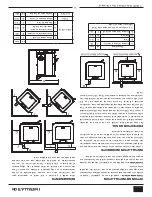
6
© 2022 United States Stove Company
OUTSIDE AIR SUPPLY
(OPTIONAL, UNLESS
INSTALLING IN A MOBILE HOME)
Depending on your location and home construction,
outside air may be necessary for optimal performance.
Your stove is approved to be installed with an outside air
intake (69FAK) which is necessary for a mobile home.
You can purchase the 69FAK through your heater dealer.
Installation instructions are supplied with the air intake
kit.
ATTENTION:
DO NOT VENT UNDER ANY PORCH, DECK,
AWNING, OR IN ANY SEMI ENCLOSED OR
ROOFED AREA. DOING SO MAY RESULT IN
UNPREDICTABLE AIRFLOW AT THE VENT CAP
UNDER CERTAIN CONDITIONS AND CAN AFFECT
THE PERFORMANCE OF YOUR STOVE, AS WELL
AS, OTHER UNFORESEEABLE ISSUES.
SECURING APPLIANCE TO THE FLOOR
Use the designated holes to secure the unit to the floor.
WARNING! DO NOT INSTALL IN SLEEPING ROOM.
CAUTION! THE STRUCTURAL INTEGRITY OF THE
MOBILE HOME FLOOR, WALL, AND CEILING/ROOF
MUST BE MAINTAINED.
WHEN INSTALLED IN A MOBILE HOME, THE STOVE
MUST BE GROUNDED DIRECTLY TO THE STEEL
CHASSIS AND BOLTED TO THE FLOOR.
In addition to the previously detailed installation
requirements, mobile home installations must meet the
following requirements:
• This stove must be securely fastened to the floor of
the mobile home using two 1/4” lag bolts that are long
enough to go through both a hearth pad, if used, and
the floor of the home.
• The heater must be electrically grounded to the steel
chassis of the mobile home with 8 GA copper wire
using a serrated or star washer to penetrate paint or
protective coating to ensure grounding.
• Vent must be 3 or 4-inch “PL” Vent and must extend
a minimum or 36” (914 mm) above the roof line of the
mobile home and must be installed using a certified
ceiling fire stop and rain cap.
• When moving your mobile home, all exterior venting
must be removed while the mobile home is being
relocated. After relocation, all venting must be
reinstalled and securely fastened.
• Outside Air is mandatory for mobile home installation.
See Outside Air Supply section and your dealer for
purchasing.
• Check with your local building officials as other codes
may apply.
VENTING REQUIREMENTS
WARNING:
• INSTALL VENT AT CLEARANCES SPECIFIED BY
THE VENT MANUFACTURER.
• DO NOT CONNECT THE PELLET VENT TO A VENT
SERVING ANY OTHER APPLIANCE OR STOVE.
• DO NOT INSTALL A FLUE DAMPER IN THE
EXHAUST VENTING SYSTEM OF THIS UNIT.
The following installation guidelines must be followed
to ensure conformity with both the safety listing of this
stove and to local building codes. Do not use makeshift
methods or compromise in the installation.
IMPORTANT:
THIS UNIT IS EQUIPPED WITH A NEGATIVE DRAFT
SYSTEM THAT PULLS AIR THROUGH THE BURN
POT AND PUSHES THE EXHAUST OUT OF THE
DWELLING. IF THIS UNIT IS CONNECTED TO A FLUE
SYSTEM OTHER THAN THE WAY EXPLAINED IN
THIS MANUAL, IT WILL NOT FUNCTION PROPERLY.
MAXIMUM VENTING DISTANCE
Installation MUST include at least 3-feet of vertical pipe
outside the home. This will create some natural draft to
reduce the possibility of smoke or odor during appliance
shutdown and keep exhaust from causing a nuisance or
hazard by exposing people or shrubs to high temperatures.
The maximum recommend vertical venting height is 12-
feet for 3-inch type “PL” vent. Total length of horizontal
INSTALLATION
Summary of Contents for KP5522
Page 11: ...Project 22 753 Model KP5522 Page 10 Appliance Front Appliance Left...
Page 12: ...Project 22 753 Model KP5522 Page 11 Appliance Right Appliance Rear...
Page 14: ...Project 22 753 Model KP5522 Page 13 Pellet Fuel Analysis...
Page 17: ...Project 22 753 Model KP5522 Page 16 Sealed Unit...
Page 54: ......
Page 55: ......
Page 56: ......
Page 58: ...Project 22 751 Model Charnwood Skye E700 Page 16 Tunnel Schematic...
Page 102: ......
Page 103: ......
Page 104: ......
Page 129: ...2022 United States Stove Company 25 NOTES...
Page 177: ...2022 United States Stove Company 25 NOTES...
Page 272: ...24 2022 United States Stove Company NOTES...
Page 308: ......
Page 309: ......
Page 311: ......
Page 312: ......
Page 318: ......
Page 319: ......
















































